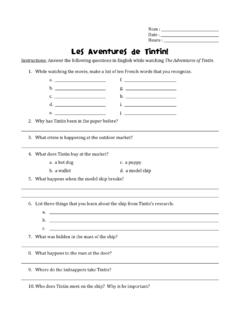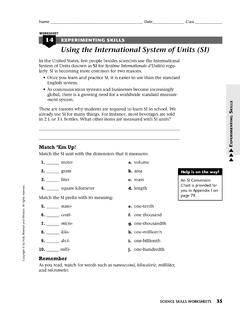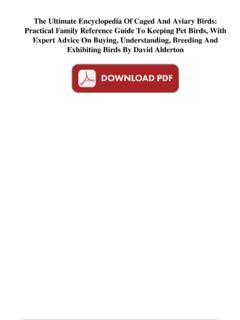Transcription of I Know Why the Caged Bird Cannot Read - Union High School
1 I Know Why the Caged bird Cannot ReadHow American High School Students Learn to Loathe LiteratureFrancine ProseFrancine Prose, who was born in the late 1940s, is a reporter, essayist, critic, and editor. She has also written more than twenty books, includ-ing poetry, fiction, and children s literature. Her novel Blue Angel (2000) was a finalist for the National Book Award, and her nonfiction works The Lives of the Muses: Nine Women and the Artists They Inspired (2002) and Reading Like a Writer: A Guide for People Who Love Books and Those Who Want to Write Them (2006) were both national best sellers. She has received numerous grants and awards, including Guggenheim and Fulbright fellowships. She is most recently the author of the satiric novel My New American Life (2011). Prose is currently a book reviewer for a num-ber of magazines and periodicals, including the New York Times Book Review and O. The following essay, published in Harper s in September 1999, is a critique of the quality of required reading in American high discussed in this essay include:I Know Why the Caged bird Sings by Maya Angelou.
2 Bantam Books, Kill a Mockingbird by Harper Lee. Warner Books, Values through Teaching Literature by Margaret Dodson. Eric/Edinfo Press, the Novel by Becky Alano. Eric/Edinfo Press, Literature by Women Authors by Carolyn Smith McGowen. Eric/Edinfo Press, most parents who have, against all odds, preserved a lively and still evolv-ing passion for good books, I find myself, each September, increasingly appalled by the dismal lists of texts that my sons are doomed to waste a School year reading. What I get as compensation is a mea sure of insight into why our society has come to admire Montel Williams and Ricki Lake so much more than Dante and Homer. Given the dreariness with which literature is taught in many American classrooms, it seems miraculous that any sentient teenager would view reading as a source of plea sure. Traditionally, the love of reading has been born and nurtured in high School En glish class the last time many students will find themselves in a roomful of people who have all read the same text and are, in theory, prepared to discuss it.
3 High School even more than college is where literary tastes and allegiances are formed: what we read in adolescence is imprinted on our brains as the dreary notions of childhood crystallize into hard B6+(B B&K B B LQGG 30 PROSE I KNOW WHY THE Caged bird Cannot read 177 The intense loyalty adults harbor for books first encountered in youth is one prob able reason for the otherwise baffling longevity of vintage mediocre novels, books that teachers may themselves have read in adolescence; it is also the most plausible explanation for the peculiar [1998] Modern Library list of the 100 Best Novels of the 20th Century, a roster dominated by robust survivors from the tenth-grade syllabus. Darkness at Noon, Lord of the Flies, Brave New World, and The Studs Lonigan Trilogy all speak, in various ways, to the vestigial teenage psyches of men of a certain age. The parallel list drawn up by students (younger, more of them female) in the Radcliffe Publishing Course reflects the equally romantic and tacky tastes (Gone with the Wind, The Fountainhead) of a later generation of ado-lescent the fact that these early encounters with literature leave such indelible impressions, it would seem doubly important to make sure that high School stu-dents are actually reading literature.)
4 Yet every opportunity to instill adolescents with a lifelong affinity for narrative, for the ways in which the vision of an artist can percolate through an idiosyncratic use of language, and for the supple gym-nastics of a mind that exercises the mind of the reader is being squandered on regimens of trash and semi-trash, taught for reasons that have nothing to do with how well a book is written. In fact, less and less attention is being paid to what has been written, let alone how; it s become a rarity for a teacher to suggest that a book might be a work of art composed of words and sentences, or that the choice of these words and sentences can inform and delight us. We hear that more books are being bought and sold than ever before, yet no one, as far as I know, is arguing that we are producing and becoming a nation of avid readers of serious has been made of the lemminglike fervor with which our universities have rushed to sacrifice complexity for diversity; for decades now, critics have decried our plummeting scholastic standards and mourned the death of cultural literacy without having done one appreciable thing to raise the educational bar or revive our moribund culture.
5 Meanwhile, scant notice has been paid, except by exas-perated parents, to the missed opportunities and misinformation that form the true curriculum of so many high School En glish own two sons, now twenty-one and seventeen, have read (in public and pri-vate schools) Shakespeare, Hawthorne, and Melville. But they ve also slogged repeat-edly through the manipulative melodramas of Alice Walker and Maya Angelou, through sentimental, middlebrow favorites (To Kill a Mockingbird and A Separate Peace), the weaker novels of John Steinbeck, the fantasies of Ray Bradbury. My older son spent the first several weeks of sophomore En glish discussing the class s sum-mer assignment, Ordinary People, a weeper and former bestseller by Judith Guest about a dysfunctional family recovering from a teenage son s suicide has heard a teacher suggest that he read Kafka, though one might suppose that teenagers might enjoy the transformative science-fiction aspects of 5 B6+(B B&K B B LQGG 30178 CHAPTER 5 EDUCATIONThe Metamorphosis, a story about a young man so alienated from his dysfunc-tional family that he turns embarrassingly for them into a giant beetle.)
6 No instructor has ever asked my sons to read Alice Munro, who writes so lucidly and beautifully about the hypersensitivity that makes adolescence a the hope of finding out that my children and my friends children were excep-tionally unfortunate, I recently collected eighty or so reading lists from high schools throughout the country. Because of how overworked teachers are, how hard to reach during the School day, as well as the odd, paranoid defensiveness that pervades so many schools, obtaining these documents seemed to require more time and dogged perseverance than obtaining one s FBI surveillance files and what I came away with may not be a scientifically accurate survey. Such surveys have been done by the National Council of Teachers of En glish (published in the 1993 NCTE research report, Literature in the Secondary Schools), with results that both underline and fail to reflect what I emerges from these photocopied pages distributed in public, private, and Catholic schools as well as in military academies, in Manhattan and Denver, in rural Oregon and urban Missouri, is a numbing sameness, unaffected by geography, region, or community size.
7 Nearly every list contains at least one of Shakespeare s plays. Indeed, in the NCTE report, Shakespeare (followed closely by John Steinbeck) tops the rosters of Ten Most Frequently Required Authors of Book-Length Works, Grades 9 12. Yet in other genres fiction and memoir the news is far more upsetting. On the lists sampled, Harper Lee s To Kill a Mockingbird and Maya Angelou s I Know Why the Caged bird Sings are among the titles that appear most often, a grisly fact that in itself should inspire us to examine the works that dominate our children s literary published in 1970, I Know Why the Caged bird Sings is what we have since learned to recognize as a survivor memoir, a first-person narrative of victimiza-tion and recovery. Angelou transports us to her childhood in segregated Arkansas, where she was raised by her grandmother and was mostly content, despite the unpleasantness of her white neighbors, until, after a move to St.
8 Louis, eight-year-old Maya was raped by her mother s can see why this memoir might appeal to the lazy or uninspired teacher, who can conduct the class as if the students were the studio audience for Angelou s guest appearance on Oprah. The author s frequently vented distrust of white soci-ety might rouse even the most sluggish or understandably disaffected ninth-graders to join a discussion of racism; her victory over poverty and abuse can be used to address what one fan, in a customer book review on , celebrated as transcending that pain, drawing from it deeper levels of meaning about being truly human and truly alive. Many chapters end with sententious epigrams vir-tually begging to serve as texts for sophomoric rumination on such questions as: What does Angelou mean when she writes, If growing up is painful for the South-10 B6+(B B&K B B LQGG 30 PROSE I KNOW WHY THE Caged bird Cannot read 179ern Black girl, being aware of her displacement is rust on the razor that threatens the throat ?)
9 But much more terrifying than the prospect of Angelou s pieties being dis-sected for their deeper meaning is the notion of her language being used as a model of poetic prose style. Many of the terrible mysteries that confront teach-ers of college freshman composition can be solved simply by looking at Angelou s writing. Who told students to combine a dozen mixed metaphors in one para-graph? Consider a typical passage from Angelou s opaque prose: Weekdays revolved on a sameness wheel. They turned into themselves so steadily and inevitably that each seemed to be the original of yesterday s rough draft. Saturdays, however, always broke the mold and dared to be different. Where do students learn to write stale, inaccurate similes? The man s dead words fell like bricks around the auditorium and too many settled in my belly. Who seriously believes that murky, turgid, con-voluted language of this sort constitutes good writing?
10 Youth and social approval allied themselves with me and we trammeled memories of slights and insults. The wind of our swift passage remodeled my features. Lost tears were pounded to mud and then to dust. Years of withdrawal were brushed aside and left behind, as hang-ing ropes of parasitic moss. To hold up this book as a paradigm of memoir, of thought of literature is akin to inviting doctors convicted of malpractice to instruct our medical students. If we want to use Angelou s work to educate our kids, let s invite them to parse her language, sentence by sentence; ask them precisely what it means and ask why one would bother obscuring ideas that could be expressed so much more simply and affably enough by a nine-year-old girl named Scout, To Kill a Mock-ingbird is the perennially beloved and treacly account of growing up in a small Southern town during the Depression. Its hero is Scout s father, the saintly Atticus Finch, a lawyer who represents every thing we cherish about justice and democ-racy and the American Way, and who defends a black man falsely accused of rape by a poor white woman.












